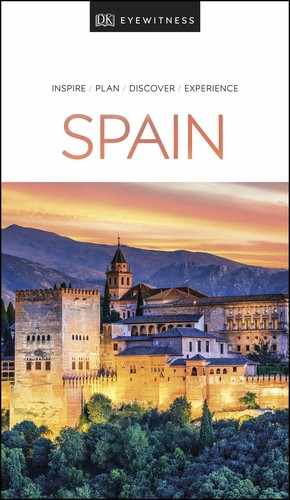g East Madrid g Contents
Experience More

t The Puerta de Alcalá, fronted by a carpet of yellow flowers
This grand ceremonial gateway was designed by Francesco Sabatini to replace a smaller Baroque gateway, which had been built by Felipe III for the entry into Madrid of his wife, Margarita de Austria. Construction began in 1769 and lasted nine years. It was built from granite in Neo-Classical style, with a lofty pediment and sculpted angels. It is best seen when floodlit at night.
This busy roundabout is named after Antonio Cánovas del Castillo, one of the leading statesmen of 19th-century Spain, who was assassinated in 1897. Dominating the plaza is the Fuente de Neptuno – a fountain with a statue depicting Neptune in his chariot. The statue was designed in 1777 by Ventura Rodríguez as part of Carlos III’s scheme to beautify eastern Madrid.
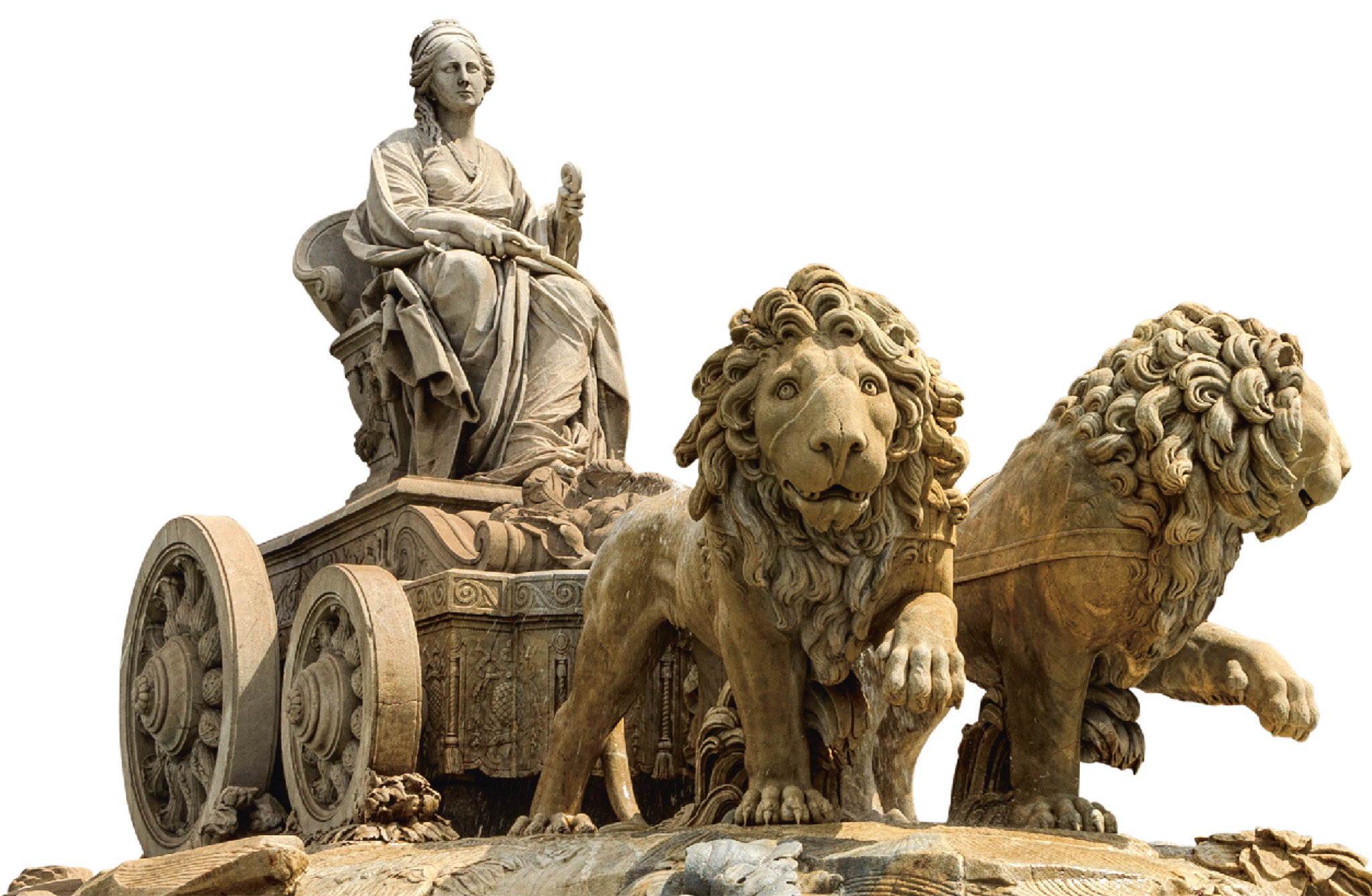
t The beautiful Fuente de Cibeles on the Plaza de Cibeles
The Plaza de Cibeles is one of Madrid’s best-known landmarks. The Fuente de Cibeles stands in the middle of the busy traffic island at the junction of the Paseo del Prado and the Calle de Alcalá. This sculpted fountain is named after Cybele, the Greco-Roman goddess of nature, and shows her sitting in her lion-drawn chariot. Designed by José Hermosilla and Ventura Rodríguez in the late 18th century, it is considered a symbol of Madrid. Around the square rise four important buildings. The most notable are the town hall and the Palacio de Comunicaciones, home to a cultural centre, CentroCentro. Built from 1905 to 1917, its appearance – white, with high pinnacles – is often likened to a wedding cake.
On the northeast side is the stone façade of the Palacio de Linares, built by the Marquis of Linares at the time of the second Bourbon restoration of 1875. Once threatened with demolition, the palace was reprieved and converted into the Casa de América, which hosts art exhibitions by Latin American artists and theatrical performances and lectures.
In the northwest corner of the Plaza de Cibeles, surrounded by gardens, is the heavily guarded Army Headquarters, housed in the buildings of the former Palacio de Buenavista. Commissioned by the Duchess of Alba in 1777, construction was twice delayed by fire. On the opposite corner is the Banco de España, constructed between 1884 and 1891. Its design was inspired by the Venetian Renaissance style, with delicate ironwork on the roof and windows. Renovation work has returned the bank to its late 19th-century glory.
"
CentroCentro
# 10am–8pm Tue–Sun ¢ Mon ∑ centrocentro.org
'
Casa de América
# 9am–3pm & 4–8pm Mon–Fri ¢ Aug & public hols ∑ casamerica.es

Great View
Panorama Drama
A ticketed lift will sweep you up to the eighth floor of CentroCentro (inside the Palacio de Comunicaciones on the Plaza de Cibeles) for the most impressive panoramic view of the city.
King Felipe V of Spain founded the National Library in 1712. Since then, it has been mandatory for printers to submit a copy of every book printed in Spain. Currently it holds some 28 million publications, plus a large number of maps, musical scores and audiovisual records. Jewels include a first-edition Don Quixote and two handwritten codes by da Vinci.
A museum looks at the history of the library as well as the evolution of writing. The library also holds regular exhibitions, talks and concerts.
Housed in the 19th-century Palacio de Santoña near the Parque del Retiro, the National Museum of Decorative Arts contains an interesting collection of furniture and objets d’art. The exhibits are mainly from Spain and date back as far as Phoenician times. There are also some excellent ceramics from Talavera de la Reina and ornaments from the Far East.
EXPERIENCE East Madrid
|
Stay Hotel Ritz An opulent belle époque hotel with a gilded interior and the rarefied air of another century. Its splendid bar has seen Dalí, Lorca and Hemingway hold court. F3 ⌂ Plaza de la Lealtad 5 ∑ mandarinoriental.com/ritzmadrid. ¡¡¡ Hotel One Shot Prado 23 Chic stylish rooms – some with balconies, and all with hardwood floors – are available for a reasonable rate. E3 ⌂ Calle del Prado 23 ∑ hoteloneshotprado23.com ¡¡¡ |
The Salón de Reinos (Hall of Kingdoms) is one of the two remaining parts of the 17th-century Palacio del Buen Retiro and gets its name from the shields of the 24 kingdoms of the Spanish monarchy, which are part of the decor supervised by court painter Velázquez. In the time of Felipe IV, the Salón was used for diplomatic receptions and official ceremonies.
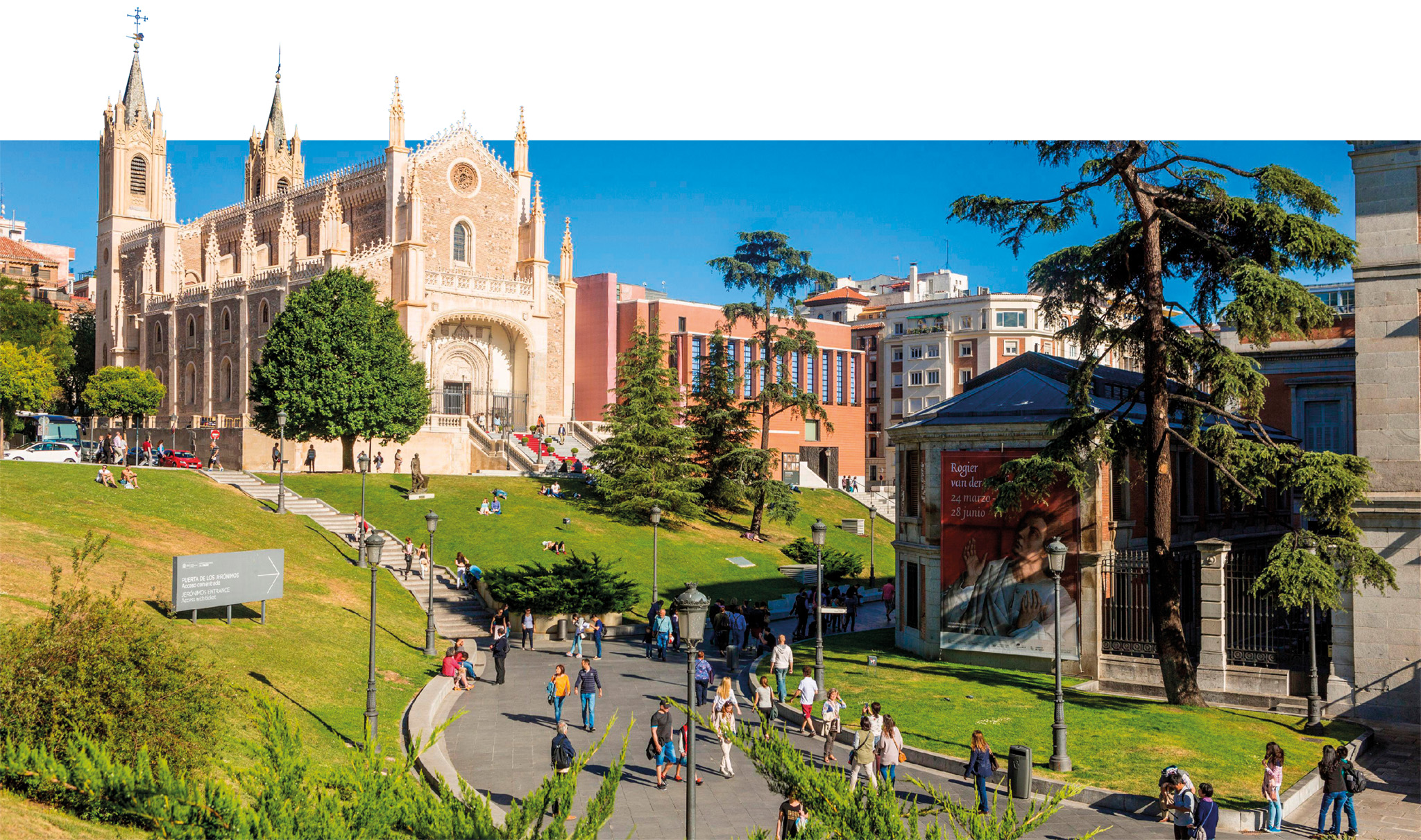
t The Parroquia de San Jerónimo el Real, next to the Museo del Prado
Built in the 16th century for Queen Isabel, but since remodelled, San Jerónimo is Madrid’s royal church. From the 17th century it became virtually a part of the Retiro palace which once stood here. The church was originally attached to the Hieronymite monastery. The cloister and part of the atrium now form part of a building at the Prado Museum.
The marriage of Alfonso XIII and Victoria Eugenia of Battenberg took place here in 1906, as did King Juan Carlos I’s coronation in 1975.
The Royal Academy of History, aptly located in the so-called Barrio de las Letras (Writers’ Quarter) is an austere brick building built by Juan de Villanueva in 1788.
In 1898, the intellectual and bibliophile Marcelino Menéndez Pelayo became director of the academy, living here until his death in 1912. The academy retains significant libraries and its collections of antiquities include more than 200,000 books, brochures and manuscripts.
The building is closed to the public and can only be viewed from the outside.
EXPERIENCE East Madrid
|
Eat TriCiclo Superb modern Spanish dishes come in three different sizes to fit every budget. E4 ⌂ Calle de Santa María 28 ∑ eltriciclo.es ¡¡¡ Estado Puro Gourmet tapas by celebrated chef Paco Roncero, who takes classic recipes and reinvents them. E3 ⌂ Plaza de Cánovas del Castillo 4 ∑ tapasenestadopuro.com ¡¡¡ Casa Alberto This taberna serves classic Madrilenian dishes in a room decorated with pictures of bullfighters. D4 ⌂ Calle de las Huertas 18 ¢ Sun D, Mon ∑ casaalberto.es ¡¡¡ |
Félix Lope de Vega, a leading Golden Age writer, moved into this house in 1610. Here he wrote over two-thirds of his plays, thought to total almost 1,000. Meticulously restored in 1935 using some of Lope de Vega’s own furniture, the house gives a great feeling of Castilian life in the early 17th century. A dark chapel with no external windows occupies the centre, separated from the writer’s bedroom by only a barred window. The small garden at the rear is planted with the flowers and fruit trees mentioned by the writer in his works. He died here in 1635.
Formally founded in 1835, this learned association is similar to a gentlemen’s club in atmosphere. It is housed in a Modernist building with a grand stairway and panelled hall hung with the portraits of famous fellows.
Although closed down during past periods of repression, the institution has remained a mainstay of liberal thought in Spain. Many leading Socialists are members, along with writers and other intellectuals.
Dominating the Plaza de Santa Ana is the Teatro Español, one of Madrid’s oldest and most beautiful theatres.
From 1583, many of Spain’s finest plays, by leading dramatists of the time such as Lope de Rueda, were first performed in the Corral del Príncipe, which originally stood on this site. In 1802 a large fire barely left the façade standing and reconstruction saw it replaced by the Teatro Español.
The Neo-Classical façade, with pilasters and medallions, is by Juan de Villanueva. Engraved on it are the names of great Spanish dramatists, including that of celebrated writer Federico García Lorca.
Hour-long guided tours are available (at noon on random days, check the website), which take in the stage, the king’s box and private rooms.
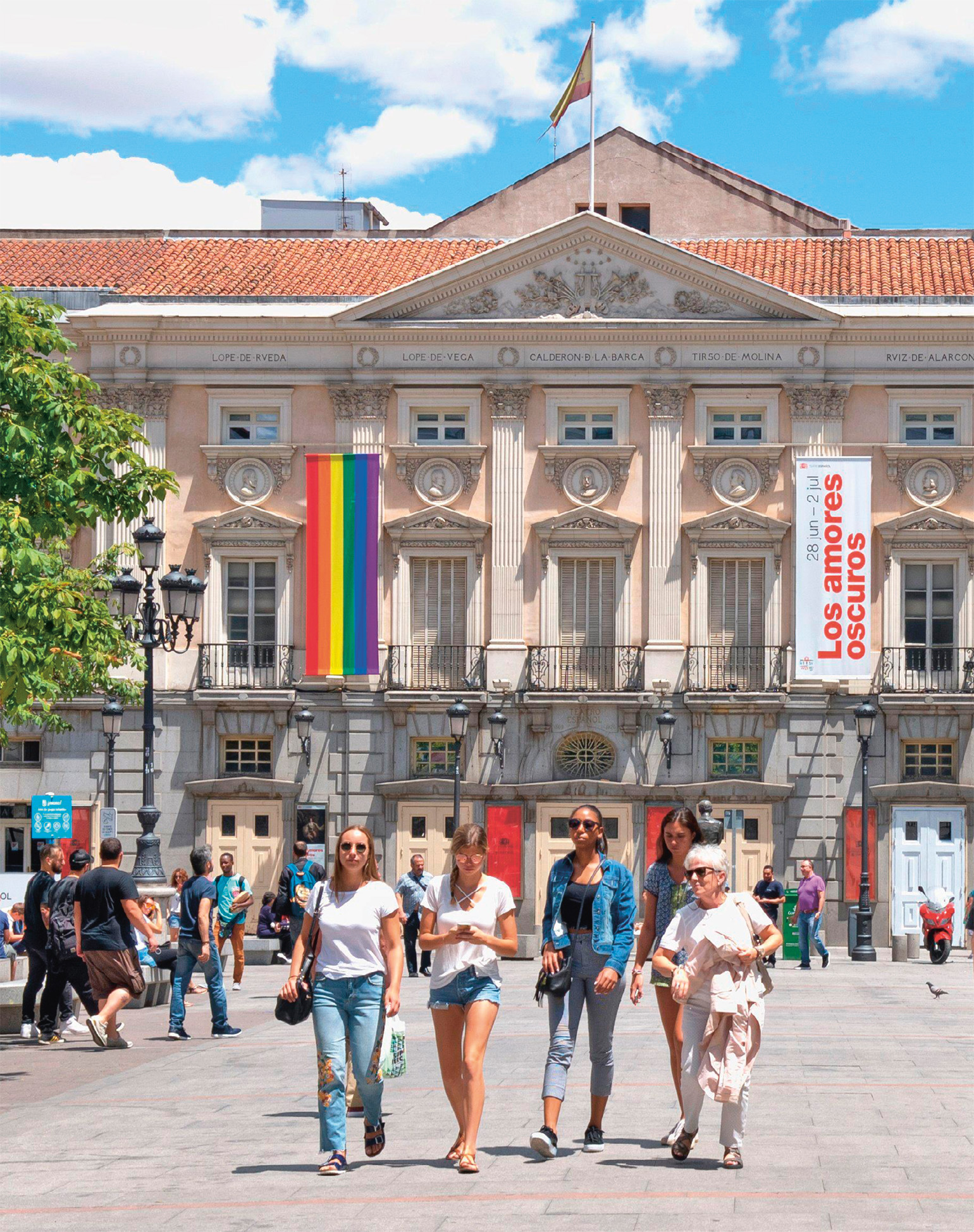
t The Neo-Classical façade of the Teatro Español, on the Plaza de Santa Ana
EXPERIENCE East Madrid

Madrid Fiestas
San Isidro
Madrid’s great party is held around 15 May in honour of St Isidore, the city’s patron saint. The occasion is marked by exhibitions, concerts and fireworks displays.
Corpus Christi
Madrileños honour the Eucharist with religious processions across the city in late May or early June.
Dos de Mayo
This holiday marks the city’s uprising against Napoleon’s troops on 2 May 1808.
New Years’ Eve
The nation focuses on the Puerta del Sol at midnight as crowds gather to swallow a grape on each chime of the clock.
This large square, overlooked by huge 1970s tower blocks, is dedicated to 15th-century explorer Christopher Columbus (Colón in Spanish).
On the south side of the square is a palace housing the National Library and the Archaeological Museum. The Post-Modernist skyscraper of the Heron Corporation towers over the plaza from the far side of the Paseo de la Castellana.
The highlight of the square, however, is the pair of monuments dedicated to Columbus. The prettiest, and oldest, is a Neo-Gothic spire erected in 1885, with Columbus at its top, pointing west. Carved reliefs on the plinth depict his “discoveries”. Across the square is the other, more modern monument – four large concrete shapes inscribed with quotations about Columbus’s journeys.
Busy with traffic, the plaza may seem an unlikely place for cultural events. But below it is a huge complex, the Teatro Fernán Gómez Centro Cultural de la Villa, named after the Spanish actor, director and writer Fernando Fernán Gómez. Exhibitions are held in its halls and the complex also includes a theatre and a café.
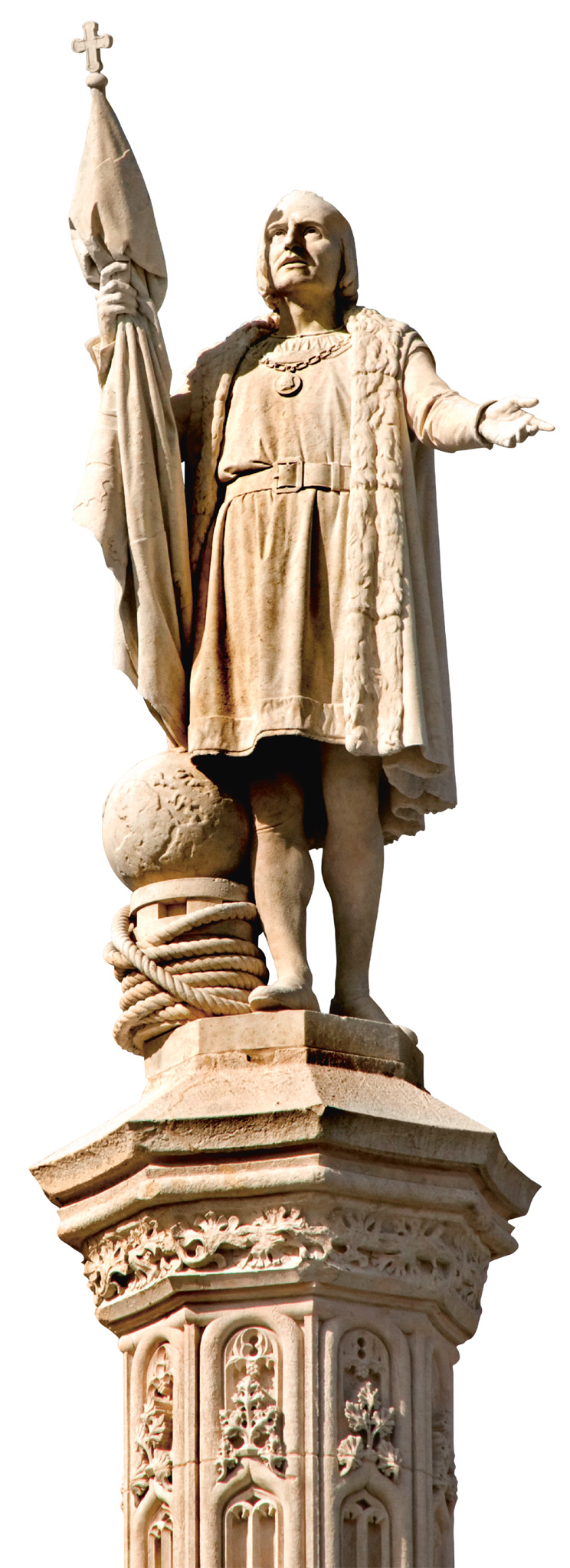
t Columbus, Plaza de Colón
" -
Teatro Fernán Gómez Centro Cultural de la Villa
⌂ Plaza de Colón 4 # 10am–10pm Tue–Sun ∑ teatrofernangomez.com

t Roman mosaics depicting the seasons and months at the Museo Arqueológico Nacional
Founded by Isabel II in 1867, Madrid’s archaeological museum houses a collection that consists mainly of material uncovered during excavations all over Spain, as well as pieces from Egypt, ancient Greece and the Etruscan civilization.
Highlights of the earliest finds include an exhibition on the ancient civilization of El Argar in Andalucía, and a display of jewellery uncovered at the Roman settlement of Numantia, near Soria.
Other exhibited pieces are devoted to the period between Roman and Mudéjar Spain. Iberian culture is also represented, with two notable funerary sculptures – La Dama de Elche and La Dama de Baza. The Roman period is illustrated with some impressive mosaics, including one from the 3rd century AD. The underside of this 1,800-year-old work shows a combat between gladiators, Simmachius and Maternus; the upper register displays Simmachius’ victory. Outstanding pieces from the Visigothic period include splendid 7th-century gold votive crowns from Toledo province.
On show from the Islamic era is well-preserved pottery uncovered from Medina Azahara in Andalucía. Romanesque exhibits at the museum include an ivory crucifix carved in 1063 for Fernando I of Castilla-León, and the Madonna and Child from Sahagún, considered a masterpiece of Spanish art.

Insider Tip
Free For All
The Plaza de Colón is home to the Teatro Fernán Gómez Centro Cultural de la Villa, which has free art exhibitions and, in summer, puppet shows and zarzuela (light opera) performances.
Madrid’s first railway service, from Atocha to Aranjuez, was inaugurated in 1851. Forty years later Atocha station was replaced by a new building, which was extended in the 1980s. The older part, built of glass and wrought iron, now houses an indoor palm garden, planted with over 500 species.
In the modern part of the station, there is a poignant memorial to the 2004 terrorist attack. It’s best viewed from below, where you look up into the dome, which is enscribed with messages of condolence.
This imposing yet attractive building is home to the Spanish parliament, the Cortes. Built in the mid-19th century, it is characterized by Classical columns, heavy pediments and guardian bronze lions. It was here, in 1981, that Colonel Tejero of the Civil Guard held the deputies at gunpoint on national television, as he tried to spark off a military coup. His failure was seen as an indication that democracy was now firmly established in Spain.
Running north from the Plaza de la Independencia to the Plaza del Ecuador, Calle de Serrano is lined with shops housed in old-fashioned mansion blocks. Top Spanish designers, such as Adolfo Domínguez and Purificación García, have boutiques towards the north. Branches of the Italian shops Versace, Gucci and Armani can be found on the Calle de José Ortega y Gasset. Lower down the Calle de Serrano, towards Serrano metro station, are two branches of the department store El Corte Inglés. On the Calle de Claudio Coello, which runs parallel with Serrano, there are lavish antique shops, in keeping with the area’s upmarket atmosphere. Under Juan Bravo’s bridge is the Museo de Arte Público de Madrid, an open-air sculpture museum.
EXPERIENCE East Madrid
|
Drink Café Gijón Of the many intellectual cafés that thrived in Madrid, from the turn of the 20th century up to the Civil War, only Café Gijón survives. F2 ⌂ Paseo de Recoletos 21 ∑ cafegijon.com |
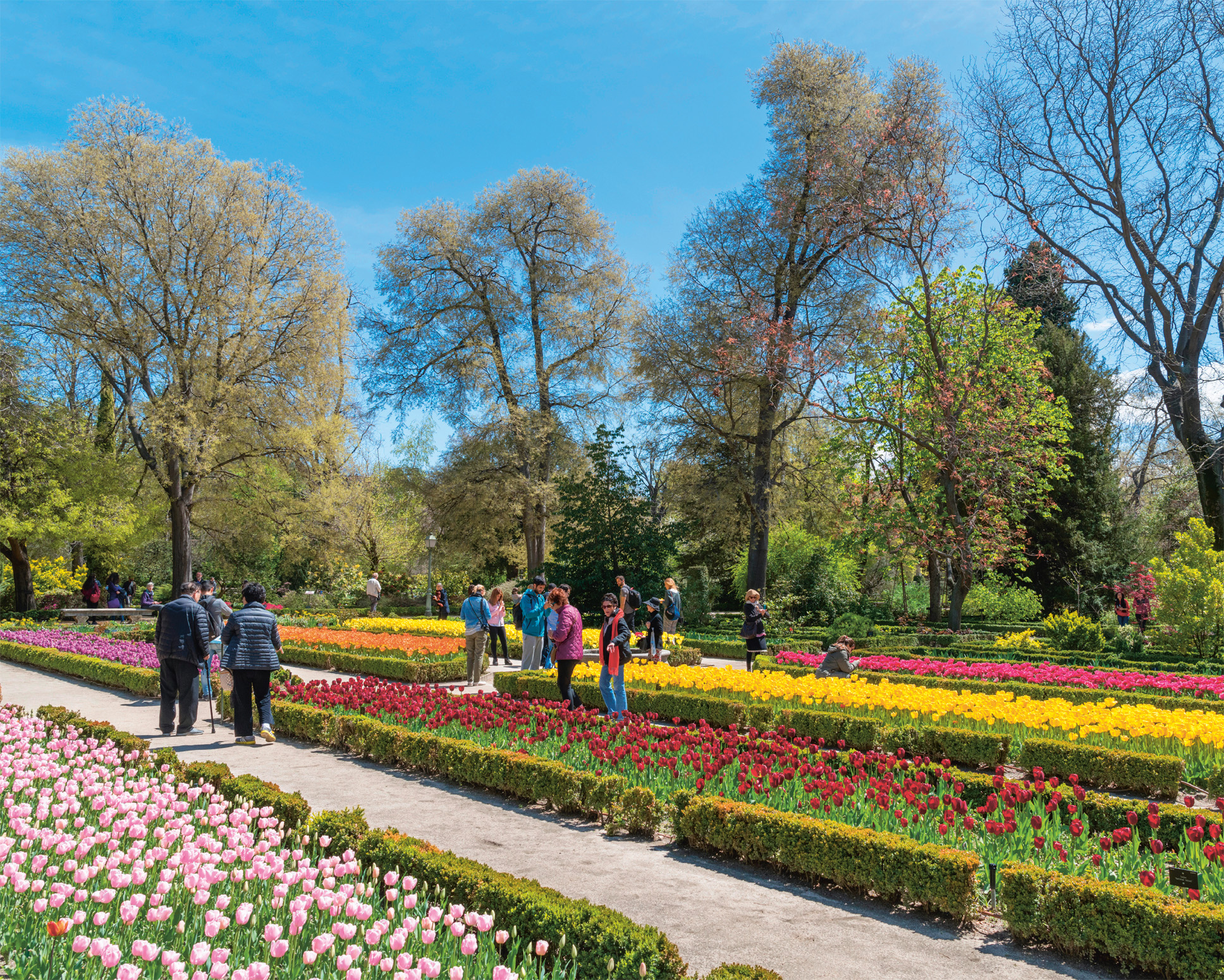
t A vibrant display of tulips at the Real Jardín Botánico, the perfect place to relax
South of the Prado are the Royal Botanical Gardens. Inspired by Carlos III, they were designed in 1781 by Gómez Ortega, Francesco Sabatini and Juan de Villanueva, architect of the Prado. Interest in the plants of South America and the Philippines took hold during the Spanish Enlightenment, and the neatly laid out beds offer a huge variety of flora, ranging from trees to herbs.
